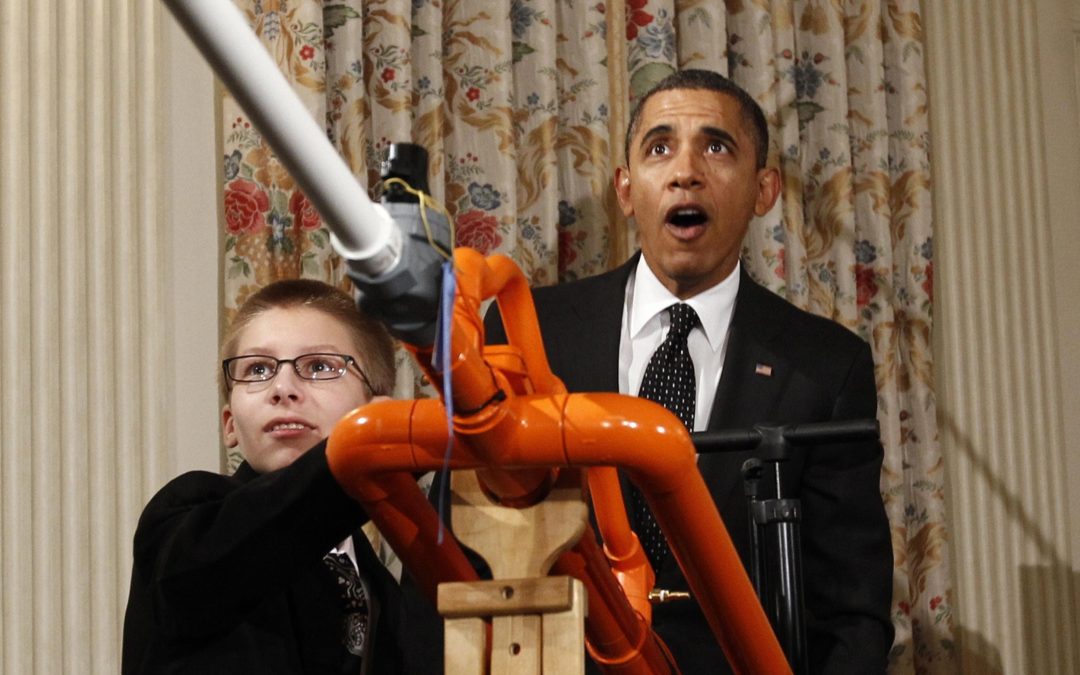He’s a president who loves science. Bring him just the facts, no emotion with that thanks. Call him Mr. Spock, but President Obama has tried his best to bring back the good reputation of our scientific community.
Today’s White House Science Fair will be the last that Obama hosts. Here’s hoping the next president will keep it going.
The fair highlights America’s best ingenuity and entrepreneurship. The students are tackling everything from combating climate change, to uncovering new ways to fight cancer, to discovering ways to reach farther beyond our atmosphere as a part of the Mars generation.
Here’s some info about some of the attendees from the White House website. If you’re not impressed with these fine young Americans, something is seriously wrong with you:
- Hannah Herbst, a 15-year-old from Boca Raton, Florida, was named America’s 2015 Top Young Scientist and won the 2015 Discovery Education 3M Young Scientist Challenge for creating BEACON, an ocean-energy probe prototype. BEACON—which Hannah created out of a desire to help her nine-year-old pen pal who lives in Ethiopia and lacks a reliable source of power and electricity—seeks to offer a stable power source to developing countries by using untapped energy from ocean currents.
- When learning of the Ebola epidemic spreading through Africa, Olivia Hallisey, 17, of Greenwich, CT, was concerned that the people who most needed diagnosis and treatment did not have access to care. Olivia created the Ebola Assay card—a temperature-independent, rapid, portable, and inexpensive diagnostic test for the detection of the Ebola virus.
- Sindhu Bala, 12, Ellie Englund, 12, Sydney Gralike, 13, Julianna Jones, 13, Reagan Mattison,12, and Christina Yepez, 13, of Girl Scout Troop #1484 from St. Louis, Missouri wanted to help a local retirement community be more environmentally friendly. The team developed “Eco Bin,” a metal bin containing a non-toxic substance (d-limonene) that dissolves Styrofoam when mixed with water, enabling households and businesses to reduce their waste. In a surprise twist, these innovators discovered that the gooey substance created by the mixture is a strong adhesive. The girls bottled and branded the substance, naming it “GlOo” and marketing it to their local school and other Girl Scout troops for art projects.
- Nathan Charles Marshall, 17, of Boise, Idaho, used a marine sediment core to examine the warming effects of two natural pulses of carbon dioxide released 55 million years ago. Nate found that Earth recovered from the first before a second, larger pulse triggered massive warming of the planet lasting tens of thousands of years. Nate believes that his findings indicate that the planet can recover from current warming trends if humankind acts quickly to curtail carbon emissions or remove atmospheric carbon dioxide.
- Yashaswini Makaram, 17, of Northborough, MA, created a new cell phone security tool that records the distinctive arm and hand motions people use to lift a cell phone from a table to uniquely identify the cell phone’s owner. To date, the technology correctly identifies a cell phone’s owner 85 percent of the time and differentiates among people with 93 percent accuracy.
- Olivia Thomas, 18, a home-schooled student from Boise, Idaho, designed a game inspired by her love of literature. At 10, Olivia became interested in creating games to express her creativity, and so taught herself to code as a means of interactive storytelling. She became immediately hooked on computer programming and began creating programs within her community to teach other girls how to code.
- Neil Davey, 20, of Gaithersburg, Maryland, took on the study of cancer. His technique uses a combination of drop-based microfluidics and polymerase chain reaction (PCR) to detect circulating tumor cell (CTC) genes, which are shed by tumors and enter the blood stream. In addition to improving early cancer detection, Neil’s solution provides the genomic details of the cancer, giving the treating doctor insights into the patients’ cancer that can enable for more-targeted “precision medicine” treatments.
- Gabriel Mesa, 16, of, Canton, Connecticut, has combined piezoelectric materials with graphene, to create a new battery technology, the “Carbon Battery”—an environmentally safe and compostable battery that generates electrical energy through mechanical instead of chemical means. The patent-pending Carbon Battery seeks to replace conventional batteries that are typically created using toxic materials.
These are just a few of our shining science stars of the future. America doesn’t need to be great again. These students prove it’s great right now!
